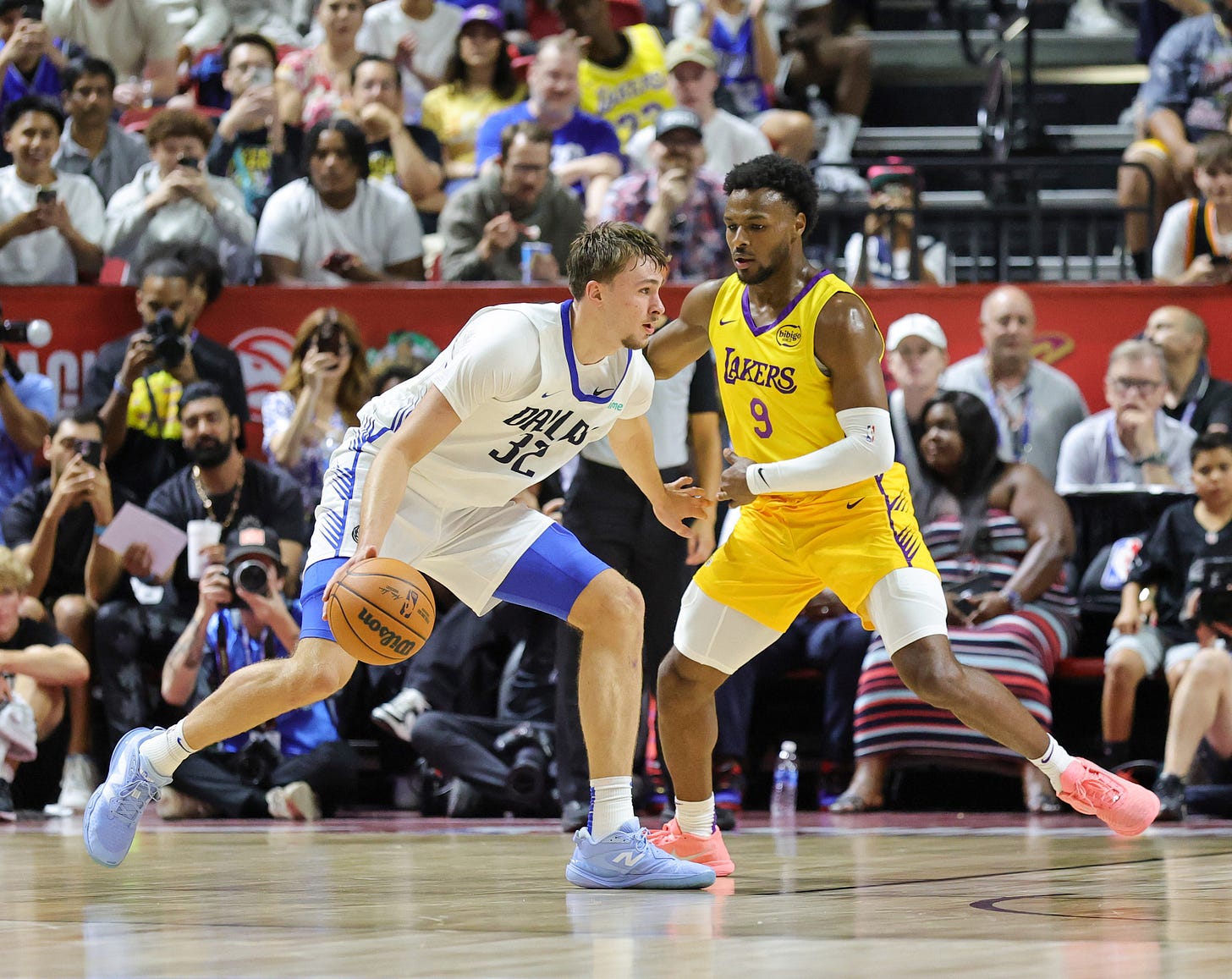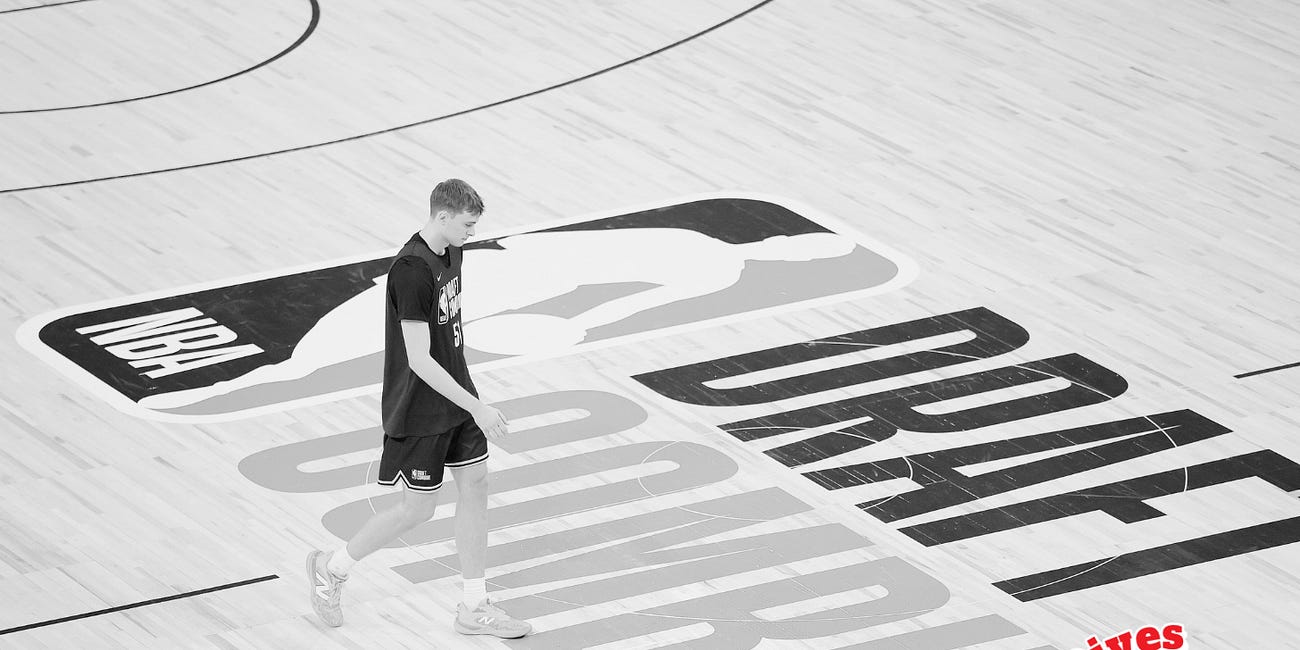Mavs-Lakers, Cooper Flagg and Other Summer League Notes
Flagg, Nembhard, Knecht, Bronny and other observations
The most hyped prospect to hit Summer League in years made his debut last night. Cooper Flagg, widely viewed as the best U.S.-based talent since Anthony Davis and Zion Williamson (and if you want a detailed breakdown of why and how extraordinary the Mavericks rookie is, check my full Flagg breakdown), took the floor for the Mavericks at the Thomas & Mack Center in Las Vegas. And it wasn’t a coincidence that his first opponent was the Los Angeles Lakers.
After the most stunning trade in recent NBA history, one that sent Luka Dončić to L.A. and brought Anthony Davis to Dallas, I wrote how these two franchises would be linked forever. The NBA clearly agrees. From putting Mavs-Lakers on the Summer League slate to placing them in the same NBA Cup group (Group B), the league is making sure to maximize the rivalry and the buzz that has surrounded both teams since that seismic February 1st deal that shook the league.
So, of course, despite spotty internet access here on my vacation in Greece, I had to check out Flagg’s debut and the first Mavericks-Lakers matchup of the 2025–26 season. Below are my observations in notes form.
Today’s notes:
Cooper Flagg’s first impression
The six-foot Ryan Nembhard standing tall
Bronny James and other Laker observations
1–Cooper Flagg’s first impression
It’s no stretch to say all eyes were on Flagg. The 18-year-old played 32 minutes and was at the center of everything. Jason Kidd kept his promise to make Flagg “uncomfortable,” giving him point guard reps and asking him to bring the ball up. The Lakers responded by pressing him full court, testing his handle and poise. Flagg embraced the challenge, calling it an experiment, and stepped out of his comfort zone by putting up 21 shots in his Summer League debut.
When a prospect is as highly touted as Flagg, I’m sure his 5-of-21 shooting and the fact he didn’t score in the second half will lead to plenty of overreactions. So, let’s start with the shooting and scoring. Summer League is an environment where ball-dominant guards who can chuck shots usually dictate the style of play. That’s not Flagg’s game, even with the experiment—and that’s completely fine. He forced a number of shots and had trouble getting to his spots with the same ease he showed against lesser collegiate competition, where he could overwhelm opponents with his NBA-ready body and size. Against NBA athletes—especially long, athletic defenders like Darius Bazley, who continues to stand out for the Lakers—that becomes much harder. That’s why many of his attempts turned into contested fadeaways. Most of Flagg’s year-one NBA experience and growth will be about learning new court spacing, adjusting to the speed and athleticism of the league, and figuring out how to get to his (new) spots to create his own shot. Draft analyst Nick Kalinowski predicted in our Draft deep-dive that Flagg’s adjustment as a shooter at the NBA level might take some time.
Draft Data Deep Dive, Part I: The Cooper Flagg Comparisons You Haven’t Heard Yet
This is part of my offseason deep-dive series. The content comes less frequently than the game-by-game coverage during the season, but with more time spent on data and analysis, each piece aims to be more in-depth, longer, and more meaningful.
We’ll also see how the Mavericks’ strategy of playing jumbo lineups, with Flagg sharing the floor with P.J. Washington, Anthony Davis, and a center, impacts his learning curve and his ability to find and get to his preferred spots. There will be some pressure, fueled by comparisons to Dončić, for Flagg to excel at self-created shots right away. But that’s neither fair nor should it be the plan or expectation.
Because what Flagg showed in this game, and throughout his season at Duke, is that he can make an impact and leave his imprint on the game without needing to score. His best attribute right now is his combination of size and speed. His most effective offensive moments came in transition, where he looks like he’ll be a force from day one of his NBA career. Which opens a more interesting question about the Mavericks’ style of play in the upcoming season, and how they’ll juggle between the vets who prefer a slower, half-court game—like Anthony Davis, Klay Thompson, and D’Angelo Russell—and the youth movement with Flagg, Dereck Lively II, Naji Marshall, and P.J. Washington that thrives in an up-and-down, fast, transition game.
Flagg’s speed and length was what defined the key play of the game with just over a minute to go. Flagg first blocked a shot as a weakside rim protector, then pushed the ball in transition and found Ryan Nembhard for the game-sealing three-pointer. Flagg finished the game with three steals and one block, which stood out to me much more than his 5-of-21 shooting. Yesterday, I wrote about new Laker Jake LaRavia and the connector archetype. I think Flagg has the potential to be an elite connector from day one.
2–The six-foot Ryan Nembhard standing tall
The biggest knock on 22-year-old Ryan Nembhard, and likely the main reason he fell into the Mavericks’ lap as an undrafted pickup, is his height. He’s officially listed at 6-foot, but measured at 5-foot-11 without shoes at the Combine.
Nembhard, college basketball’s assist leader at 9.8 per game as a senior at Gonzaga, is the opposite of what we usually see in Summer League guard play. Which is playing too fast, too out of control, and being way too concerned with their own shots and numbers instead of setting up others. Nembhard was the Mavericks’ leading scorer with 21 points, but most of his shots came from simply getting to his spots and taking what the defense gave him. At 22 years old, Nembhard could end up being an undrafted gem. He plays with confidence and poise, like someone who knows exactly what he’s doing. He’s never rushed, never out of control. He knows how to run pick-and-roll, how to snake or hostage dribble, how to get to his spots. And he showed an NBA-ready shot— the mid-range pull-up out of the pocket.
The main concern with him is still his size. But his brother—Andrew Nembhard, one of digginbasketball’s favorite players—has already shown that a size disadvantage can be overcome with relentless effort and aggressive on-ball pressure. Andrew may be five inches taller, but the blueprint is there.
3-Bronny James and other Laker observations
Speaking of size, Bronny James is another player trying to find his niche in a league that’s becoming increasingly difficult for undersized guards to survive in.
Bronny isn’t the shooter or playmaker that Nembhard is, so his path to earning a role in an NBA rotation likely depends on becoming an ultra-aggressive on-ball defender in the mold of Davion Mitchell or Gary Payton II. He’s shown some flashes of that in his Summer League games, including a couple of no-back-down stands against the much taller Flagg, but not yet to the extent that he stands out as a disruptor. It hasn’t translated into defensive playmaking stats—he has just one steal and no blocks through two games so far. His college and early NBA data also don’t stand out in that regard, especially when compared to a defensive standout like Gary Payton II.
Dalton Knecht is the other high-profile player on this Lakers Summer League squad. After an up-and-down rookie campaign that ended with only four meaningless playoff minutes, there was an expectation for him to take a noticeable leap in his sophomore season—starting by standing out against lesser competition in the summer. That hasn’t happened so far. Knecht has shown flashes of long-distance shot-making—he’s 7-of-15 from beyond the arc over the last two games after a rough shooting night in the opener. But his extended on-ball reps, whether as a driver, finisher, or pick-and-roll ball-handler, haven’t shown convincing signs of progress. Which, combined with the addition of Jake LaRavia, who looks much more potent in those areas and is a much better defender, could make it harder for Knecht to secure a spot in the rotation or a long-term future as a Laker.
The player who’s made the strongest impression for the Lakers through their first three Summer League games is Darius Bazley. The lanky 6'9" forward with a 7'0" wingspan is an above-average NBA athlete who raised eyebrows with his defensive playmaking, collecting several blocks and altering shots at the rim. He also showcased his speed and ability to push the ball off a rebound and attack downhill, whether in transition or on drives that mostly end with a spin move. Because of his NBA tenure—players with four or more years of experience are ineligible for two-way contracts—the Lakers would need to find a full roster spot if they’ve seen enough from the 25-year-old. The Lakers already have two similar players in Jarred Vanderbilt and Maxi Kleber, both of whom can serve as secondary rim protectors or play small-ball center minutes. And while there are questions about their long-term futures with the team, both are still under contract for next season, which could make carving out a spot for Bazley difficult.









I think that the really interesting question for Flagg is whether pushing him into too much of a ball handling role early will slow his development in other facets of the game. The Mavs are going to be under tremendous pressure both to win now and have Flagg blossom into the same early trajectory as Luka did. I think that’s unfair to Flagg this early in his career. The expectation is that he’ll win ROY, the Mavs will make a deep playoff run, and Kyrie will come back at an elite level this year. Too much pressure. Has any team managed to make the 2-timeline strategy work (except the Spurs)? It will be fascinating to watch either way!